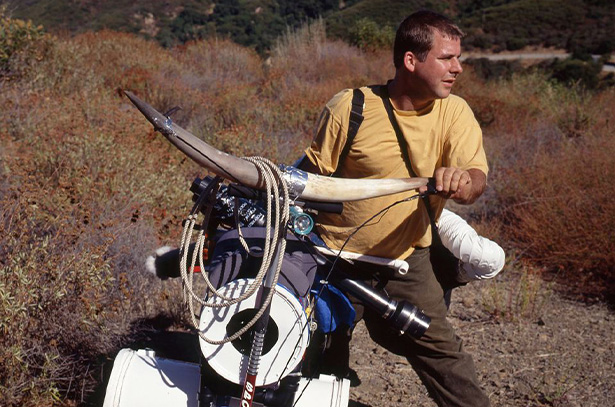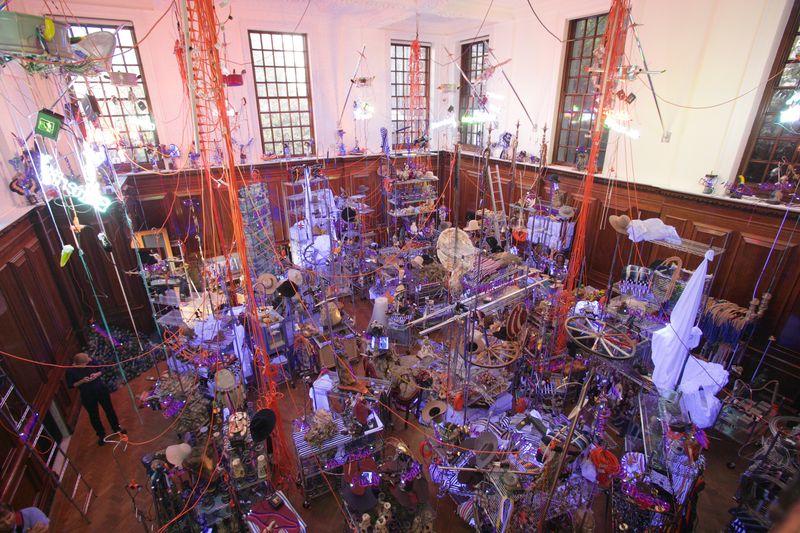Hauser and Wirth London are pleased to announce the first major UK solo exhibition by Los Angeles-based artist Jason Rhoades. The Black Pussy… and the Pagan Idol Workshop refers to a specific group of 360 lonely sculptures and idols, constructed from a core collection, as well as other elements assembled by the artist. This diverse array of objects serves as a type of palette, or pool, from which the artist reconstructs the collection of idols once housed within the Ka’bah in the time before Mohammad. The Black Pussy is an interpretation of, and sequel to, the 360 pagan idols destroyed in the 7th century when he declared that there is only One God and that he cannot be represented in material form.
The central elements of the collection are: 805 Egyptian-made Hookah Pipes and paraphernalia from a seized shipping container; 556 unique Dream Catchers (a native American fetish object used to filter dreams, and commonly found hanging from the rear-view mirror of a car) bought on ebay; 180 beaver-felt Cowboy Hats; and 147 ancient Gongshi Stones from China (otherwise referred to as Scholar’s Rocks), from a private collection. Rhoades believes that these beautifully ornate rocks, which are often mounted on decorative stands, symbolize the Chinese creation myth and reflect our understanding of our spiritual place in the world. The installation also includes Black Pussy Words made from UV or black light, that represent a continuation of the artist’s ongoing accumulation of various interpretations of the word “vagina.” The collection also houses approximately 35 other subsidiary elements. In Rhoades’ view, all of these assembled objects “retain a kind of Arabian-style thingy, while simultaneously being thrust through history, scraping and bumping against the utilitarian and decorative arts of Louis’ and Georges’, before landing somewhere in Back to the Future and a future China”.
The resulting moiré of chrome shelves, coloured chandeliers, pure UV black light, and ancient stones is an interpretation of the intersection between commerce and belief that the artist sees reoccurring throughout history. Rhoades proffers that the seemingly simple idea that culture must be protected is, in fact, a complex and problematic notion in pre-Islamic history, as well as in our own time. As with present-day museums, the Ka’bah once existed as a kind of safe haven; a holy place for various idolatry cults and tribes located in the region. The Ka’bah was originally built by Abraham and then adapted by local tribes as a landmark along the Arabian trade routes. For a fee, these clans would house and then tend to the idols as Mecca became a significant site of worship and commerce.
With this exhibition, Rhoades transforms the gallery, which was formerly a bank, into a workshop (complete with laundry), where he will reinterpret the fetishized idols and lonely sculptures. During the course of the exhibition, the artist will ask certain individuals to influence the construction and placement of idols and sculptures. These interactions culminate in a tight-knit group of works divided between the London gallery and the artist’s private showroom in Los Angeles, where an ongoing engagement with the collection continues. The Black Pussy represents the final part in a trilogy of works starting with Meccatuna, (New York), and My Madinah. In pursuit of my ermitage…, (St. Gallen). At this juncture, Rhoades engages with multiple aspects of respect and insolence, as well as what he considers to be the feline mystique of the black pussy.
Jason Rhoades (b. 1965). Lives and works Los Angeles. Major recent solo exhibitions include My Madinah. In pursuit of my ermitage… 2004, Hauser & Wirth Collection, St. Gallen; Meccatuna 2003, David Zwirner, New York; PeaRoeFoam, My Special Purpose, 2002; Museum Moderner Kunst Stiftung, Vienna and Perfect World, 1999; Deichtorhallen Hamburg. Recent group exhibitions include 'Dionysiac’, 2005, Centre Georges Pompidou, Paris; and Friedrich Christian Flick Collection, Hamburger Bahnhof, Berlin, 2004. Rhoades’ works are held in major public collections, including Tate Modern, London; Whitney Museum of American Art, New York; Guggenheim Museum, New York; and The Rubell Family Collection, Miami.














